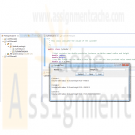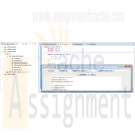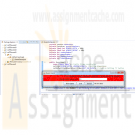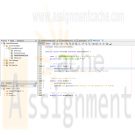Search results for 'using'
-

PRG 420 Week 2 Simple Commission Calculation Program Part 1
$15.00PRG 420 Week 2 Simple Commission Calculation Program Part 1
Learn More
Write a Java™ application using NetBeans™ Integrated Development Environment (IDE) that calculates the total annual compensation of a salesperson. Either a GUI graphic user interface) program or non-GUI program is acceptable. Consider the following factors:
• A salesperson will earn a fixed annual salary of $25,000.00.
• A salesperson will also receive a commission as a sales incentive. Commission is a percentage of the salesperson’s annual sales. The current commission is 10% of total sales.
• The total annual compensation is the fixed salary plus the commission earned.
The Java™ application should meet these technical requirements:
Create a NetBeans project and name it XXXIA2. XXX is your last name. It is important to use your last name so that each student’s project name is unique. When your team evaluation the members’ program, the team will know whom the program belong to. Your system can also load in multiple projects without conflicting project names. The number 2 in the file name is the academic week number.
• The application should have at least one class, in addition to the application’s controlling class (a controlling class is where the main function resides).
• There should be proper documentation in the source code.
• The application should ask the user to enter annual sales, and it should display the total annual compensation.
Because NetBeans produces multiple files for one project, the best method to submit an assignment is to zip the files. There should be one project folder created by NetBeans using your project name. Zip the folder. Submit your NetBeans project zip file. -

PRG 420 Week 3 Simple Commission Calculation Program Part 2
$15.00PRG 420 Week 3 Simple Commission Calculation Program Part 2
Learn More
Modify the Week Two Java™ application using Java™ NetBeans™ IDE to meet these additional and changed business requirements. Either a GUI (graphic user interface) program or non-GUI program is acceptable.
• The company has recently changed its total annual compensation policy to improve sales.
• A salesperson will continue to earn a fixed salary of $25,000.00. The current sales target for every salesperson is $120,000.
• The sales incentive will only start when 80% of the sales target is met. The current commission is 10% of total sales.
• If a salesperson exceeds the sales target, the commission will increase based on an acceleration factor. The acceleration factor is 1.25 which means all sales above the sales target will be earning 25% commission.
• The application should ask the user to enter annual sales, and it should display the total annual compensation.
• The application should also display a table of potential total annual compensation that the salesperson could have earned, in $5000 increments above the salesperson’s annual sales, until it reaches 50% above the salesperson’s annual sales.
Sample Table: Assuming a total annual sales of $100,000, the table would look like this:
Total Sales Total Compensation
100,000 <<Program calculated value>>
105,000 <<Program calculated value>>
110,000 <<Program calculated value>>
115,000 <<Program calculated value>>
120,000 <<Program calculated value>>
125,000 <<Program calculated value>>
130,000 <<Program calculated value>>
135,000 <<Program calculated value>>
140,000 <<Program calculated value>>
145,000 <<Program calculated value>>
150,000 <<Program calculated value>>
The Java™ application should also meet these technical requirements:
Create a NetBeans project and name it XXXIA3. XXX is your last name. It is important to use your last name so that each student’s project name is unique. When your team evaluation the members’ program, the team will know whom the program belong to. Your system can also load in multiple projects without conflicting project names. The number 3 in the file name is the academic week number.
• The application should have at least one class, in addition to the application’s controlling class.
• The source code must demonstrate the use of conditional and looping structures.
• There should be proper documentation in the source code.
Because NetBeans produces multiple files for one project, the best method to submit an assignment is to zip the files. There should be one project folder created by NetBeans using your project name. Zip the folder. Submit your NetBeans project zip file. -

PRG 420 Week 4 Simple Commission Calculation Program Part 3
$15.00PRG 420 Week 4 Simple Commission Calculation Program Part 3
Learn More
Modify the Week Three Java™ application using Java™ NetBeans™ IDE to meet these additional and changed business requirements. Either a GUI (graphic user interface) program or non-GUI program is acceptable.
• The application will now compare the total annual compensation of at least two salespersons.
• It will calculate the additional amount of sales that each salesperson must achieve to match or exceed the higher of the two earners.
• The application should ask for the name of each salesperson being compared.
The Java™ application should also meet these technical requirements:
Create a NetBeans project and name it XXXIA4. XXX is your last name. It is important to use your last name so that each student’s project name is unique. When your team evaluation the members’ program, the team will know whom the program belong to. Your system can also load in multiple projects without conflicting project names. The number 4 in the file name is the academic week number.
• The application should have at least one class, in addition to the application’s controlling class.
• The source code must demonstrate the use of Array or ArrayList.
• There should be proper documentation in the source code.
Because NetBeans produces multiple files for one project, the best method to submit an assignment is to zip the files. There should be one project folder created by NetBeans using your project name. Zip the folder. Submit your NetBeans project zip file. -

CIS355A iLab 1 ShowEscapeSequences Circle and PracticeArithmeticOperators Programs
$15.00CIS355A iLab 1 ShowEscapeSequences Circle and PracticeArithmeticOperators Programs
In this lab you will learn how to use the Java Software Development Kit (SDK) with the Eclipse programming tool. In addition, you will create three simple Java programs.
Deliverables
Program files for each of the following three programs.
1. ShowEscapeSequences.java
2. Circle.java
3. PracticeArithmeticOperators.java
At the beginning of ALL your programs, put a comment box that includes the program name, your name, and a brief description of the program.iLAB STEPS
STEP 1: ShowEscapeSequences (10 points)
Write a Java program named ShowEscapeSequences.java that displays the following.
I really like
CIS355A
"Business Application Programming with Lab using JAVA"STEP 2: Circle (15 points)
Write an application called Circle.java that inputs from the user the radius of a circle as an integer and prints the circle’s diameter, circumference, and area. Use the example program and GUI technique message dialog box shown in the Week 1 Lecture.
Use the following formulas.
diameter = 2 * radius
circumference = 2 * Math.PI * radius
area = Math.PI * radius * radius
Use the predefined constant Math.PI for your calculation. This constant is more precise than the value 3.14159. Class Math is defined in the java.lang package so you do not need to import it.STEP 3: PracticeArithmeticOperators (15 points)
Learn More
Write an application called PracticeArithmeticOperators.java that asks the user to enter two numbers. The program is to convert these numbers from String to type int and then print in a tabular format the sum, the difference, the product, and the quotient of the two numbers entered. Use the example program shown in the Week 1 Lecture. For example, if the user enters 25 and 5, the following should be displayed.
Operation Result
25 + 5 30
25 – 5 20
25 * 5 125
25 / 5 5 -

CIS355A iLab 3 Cylinder and Date Java Programs
$15.00CIS355A iLab 3 Cylinder and Date Java Programs
In This lab you will create two programs that use classes and methods.
Deliverables
Program files for each of the following two programs
1. Cylinder
2. DateiLAB STEPS
STEP 1: Cylinder
Create a class called Cylinder.java that contains two double-precision instance variables named radius and height. The class should include a constructor that initializes the radius and height variables. Also, you need a class method named volume() that returns the volume of a Cylinder object. The volume of a cylinder is given by its radius squared times its height times Pi (radius * radius * height * Math.PI). You can either use the value 3.1416 for Pi or use the Java provided value named Math.PI.
Write a class called CylinderTest.java and declare an array of three Cylinder objects to call the methods you declared in the Cylinder class. Make sure that all class methods are called from main(). Have main() display the value returned by volume() and verify the returned value by hand calculations (paper/pencil). Prompt the user to enter the values for the radius and height of each Cylinder object in the array.
Learn More
STEP 2: Date (20 points)
Create a program called Date.java to perform error-checking on the initial values, for instance: fields month, day, and year. Also, provide a method nextDay() to increment the day by one. The Date object should always remain in a consistent state.
Write a program called DateTest.java that prompts the user to enter the month, day, and year as numeric values. This program then creates a Date object using the Date class you just created and tests the nextDay() method. This can be done in a loop of 40 iterations: the Date object calls the nextDay() method and prints the date during each iteration of the loop. This loop is to illustrate that the nextDay() method works correctly. Test the following cases:
a. Incrementing into the next month, for example, use date: 02/28/2011
b. Incrementing into the next year, for example, use date: 11/27/2011
c. Incrementing into the next month in a leap year, for example, use date: 02/28/2012
Sample Program Output:
Checking increment
Date object constructor for date 11/27/2011
Incremented Date:11/28/2011
Incremented Date:11/29/2011
Incremented Date:11/30/2011
Day 31 invalid. Set to day 1.
Incremented Date:12/1/2011
Incremented Date:12/2/2011
...
Incremented Date:12/30/2011
Incremented Date:12/31/2011
Day 32 invalid. Set to day 1.
Incremented Date:1/1/2012
Incremented Date:1/2/2012
Incremented Date:1/3/2012
Incremented Date:1/4/2012
Incremented Date:1/5/2012
Incremented Date:1/6/2012 -

CIS355A iLab 4 InheritanceTest DayGui and OfficeAreaCalculator Java Programs
$15.00CIS355A iLab 4 InheritanceTest DayGui and OfficeAreaCalculator Java Programs
In this lab, you will create one project that uses inheritance and two simple Graphical User Interfaces (GUI) programs.
Deliverables
Program files for each of the following three programs
1. InheritanceTest
2. DayGui
3. OfficeAreaCalculatoriLAB STEPS
STEP 1: InheritanceTest (20 points)
Write a program called InheritanceTest.java to support an inheritance hierarchy for class Point-Square-Cube. Use Point as the superclass of the hierarchy. Specify the instance variables and methods for each class. The private variable of Point should be the x-y coordinates. The private data of Square should be the sideLength. The private data of Cube should be depth. Each class must provide applicable accessor, mutator, and toString() methods for manipulating private variables of each corresponding class. In addition, the Square class must provide the area() and perimeter() methods. The Cube must provide the area() and volume() methods.
Write a program that instantiates objects of your classes, ask the user to enter the value for x, y, and sideLength, test all instance methods and outputs of each object’s perimeter, area, and volume when appropriate.STEP 2: DayGui (10 points)
Write a program called DayGui.java that creates a GUI having the following properties
Object Property Setting
JFrame Name Caption Layout mainFrame Messages FlowLayout
JButton Name Caption Mnemonic cmdGood Good G
JButton Name Caption Mnemonic cmdBad Bad B
Add individual event handlers to your program so that when a user clicks the Good button, the message "Today is a good day!" appears in a dialog box, and when the Bad button is clicked, the message "I'm having a bad day today!" is displayed. The following tutorial shows you much of the code solution. Feel free to use the tutorial, but make changes so that you are not simply copying the tutorial code for your entire solution. To make this different from the tutorial, change the colors of the buttons and panel. Also, add this application to a tabbed pane along with the program you will complete in the next step, Step 3. The following tutorials will likely be useful as you work to complete this step:
• JTabbedPane
• Tutorial to Write Your First GUISTEP 3: OfficeAreaCalculator (10 points)
Learn More
Write a program called OfficeAreaCalculator.java that displays the following prompts using two label components
• Enter the length of the office:
• Enter the width of the office:
Have your program accept the user input in two text fields. When a button is clicked, your program should calculate the area of the office and display the area in a text field with a label of Area. This display should be cleared whenever the input text fields receive the focus. A second button should be provided to terminate the application (Exit button).
The following tutorial shows you much of the code solution. Feel free to use the tutorial, but make changes so that you are not simply copying the tutorial code for your entire solution. To make this different from the tutorial, change the colors of the panel. Also, add this application to the same tabbed pane (see the JTabbedPane tutorial) as the application you built in Step 2, the DayGui application.
• Office Area Calculator Tutorial -

CIS355A iLab 5 GuessGame and Text File I/O Java Programs
$15.00CIS355A iLab 5 GuessGame and Text File I/O Java Programs
In this lab you will create a single program that creates and reads a sequential file. All outputs must be GUI-based without using JOptionPane.
Deliverables
Program files for each of the following two programs
1. GuessGame
2. Text File I/OiLAB STEPS
STEP 1: GuessGame
Write a program named GuessGame.java that plays the game “guess the number” as follows: Your program chooses the number to be guessed by selecting an integer at random in the range 1–1000. The program then displays the following in a label.
I have a number between 1 and 1000 -- can you guess my number?
Please enter your guess: ____________________
A JTextField should be used to input the guess. A JButton must be provided to allow the user to press each time a guess is entered. As each guess is input, the background color should change to either red or blue. Red indicates that the user is getting warmer, and blue indicates that the user is getting colder. A JLabel should display either Too High or Too Low to help the user zero in on the correct answer. When the user gets the correct answer, Correct! should be displayed, and the JTextField used for input should be cleared and changed to be uneditable. Also, a JButton should be provided to allow the user to play the game again. When the New Game JButton is clicked, a new random number should be generated and the input JTextField changed to be editable. A JButton must be provided to allow the user to exit the application. Also provide a count of the number of guesses the user entered when the correct number is guessed.STEP 2: Text File I/O (20 points)
Learn More
Write a program called TextFileIO.java to create a file named numbers.dat. Then create an algorithm that writes all even numbered integers from 1 to 100, separated by a comma. After the file has been created, close and reopen the file and display the results to the screen. After the results have been displayed append the odd number integers from 1 to 100, separated by a comma to the end of the file. Reopen the file and display the results. The contents of the file should be the even numbers from 1 to 100 separated by a comma followed by the odd number from 1 to 100 separated by a comma. The output of this program would be something like the following
2,4,6,8,10,12,14,……,98,100
2,4,6,8,10,12,14,……,98,100,1,3,5,7,9,……..97,99 -

CMIS 141 Project 3 Stringed Musical Instrument Java Class and UML class diagram
$25.00CMIS 141 Project 3 Stringed Musical Instrument Java Class and UML class diagram
This project focuses on demonstrating your understanding of classes and objects. Before attempting this project, be sure you have completed all of the reading assignments listed in the syllabus to date, participated in the weekly conferences, and thoroughly understand the examples throughout the chapters. The project requirements include:
1. Design and implement a stringed musical instrument class using the following guidelines:
a. Data fields for your instrument should include number of strings, an array of string names representing string names (e.g. E,A,D,G), and boolean fields to determine if the instrument is tuned, and if the instrument is currently playing. You are welcome to add additional data fields if you like.
b. A constructor method that set the tuned and currently playing fields to false.
c. Other methods 1) to tune the instrument, 2) to start the instrument playing, and 3) to stop the instrument from playing.
d. Other methods as you see fit (Add at least one unique method).2. Create a UML class diagram using a diagram tool (e.g. PPT, Visio) of your choice. Prepare the diagrams and place them in a word document along with a brief description of each of your classes.
3. Create Java classes for your instruments. Be sure that your code matches your design specifications and some minimal functionality is included. For example, if you called the violin.play() method, you should at least print that the violin is playing. Similar functionality should be supplied when you stop playing, tune or call any of your methods. For example:
public void playviolin() {
System.out.println("The violin is now playing.");
}4. Write the output from your Instrument class methods to a text file that a user entered from the command line arguments (e.g. java Mynamep3tst myfilename.txt). This allows your program to accept filenames from the user via a command line argument.
5. Finally, create a Java test class that simulates using your instrument class. In your test class be you should at a minimum: a) Construct 10 instances of your instrument, b) tune your instruments, c) Start playing your instrument, d) Call your unique method, and e) Stop playing your instruments. (Hint: Arrays and Loops will make your job easier and result in more efficient code!)
6. Your programs should compile and run without errors.
7. Be sure to test your program carefully. Provide a list of comprehensive test cases used to validate your application and include these test cases in your word document containing your UML diagrams and descriptions. Similar to Project 1, your test data can be shown in a table that includes input data, expected output, actual output and pass/fail results from the test.
Learn More -

Dreams Travel Agency Java GUI Both parts
$20.00Dreams Travel Agency Java GUI Both parts
Learn More
Field of Dreams Travel Agency has begun offering travel packages to baseball fans wanting to attend major league baseball games. The company offers a package allowing a fan to attend games in four cities of his or her choice, including transportation by car, tickets, lodging, and food. Assume that the fan lives in the city hosting one of the 30 major league baseball teams. The fan will travel from his or her home to the city of one of the teams of his choice, then will proceed to the city of one of the other teams and so on until all teams have been visited. Then, the fan will return home. Create a Java program that will compute the minimum cost of the trip. Your cost will be the cost of transportation (fuel cost per gallon/ miles per gallon * number of miles between ballparks), cost of tickets, cost of lodging, and cost of food. Ask the user his home city, which cities he wants to visit, the price of fuel, the fuel economy of his vehicle, the cost of lodging per day and the cost of food per day. Your program will compute the costs of all 24 possible routings and choose the minimum cost route. Mark up the minimum cost by 20% to arrive at the cost that will be quoted to the customer.
For this week, you need only to create the GUI using Java Swing and create the basic classes that will accept the inputs from the user. We will create the functionality of these classes in the second assignment.
We will discuss strategies for preparing this program in the first week of class and you can create the program in the second week of class. That is done and I have a program with no function so here is the second part: Expand the model classes you created in the first assignment. Implement the functionality that will use the inputs offered by the user and prepare a quote for the customer according to the requirements specified in the first assignment. Upon clicking a Quote button on the GUI, the program should post a dialog box with the quote. Upon clicking the Print Quote button, write the quote out to a text file. This program was built on NETBEANS -

LastWord Java Program
$5.00LastWord Java Program
Learn More
1 LastWord.java
You will write a Java program with the file name LastWord.java. The purpose of this program is to scan through a file and find in the file:
1. The word that is closest to the beginning of the dictionary
2. The word that is closest to the end of the dictionary
3. The longest word
For the purpose of this program, a word is defined as a string of characters delimited by whitespace that starts with a letter and ends with a letter. If a string of character delimited by whitespace that starts with one or more non-letters, they should be trimmed until the first character is a letter. Same should be done to the trailing non-letters. For example, the string of character “quote” should be trimmed to quote, --dash-- should be trimmed to dash. The non-letter enclosed by letters should be left alone. This definition of a word may make your English teachers cringe, but will be much easier to implement.
The lexicographical order of the words can be determined simply by using the compareToIgnoreCase() method of String class.
The input file name should be entered by a JOptionPane input dialog box.
2 Suggested Procedure
1. Start the program by popping up an input dialog box to ask user for a file name.
2. Instantiate a FileReader using the file name wrapped in a BufferedReader.
3. nstantiate a FileWriter wrapped in a BufferedWriter. The output file name may be hardcoded.
4. Test the program by reading the input file and write the input to the output file. Compare the input file and output file.
5. Instantiate a Scanner that scans the BufferedReader. By default the Scanner delimits the tokens by whitespaces. Write the scanned tokens, one per line, to the output file. Exam the output file.
6. Write a new public class named WordSmith. Create a static method trim() to remove the non-letters around the words. Test WordSmith.trim() until you are satisfied.
7. Back to LastWord, between Scanner output and write to output, insert a call to WordSmith.trim(). Create a test file with all the possible scenarios you can think of. It will be more effective if you write out the word before and after trim() is called side-by-side on the same line.
8. Consider sharing your test file at DocSharing.
9. Add the code to LastWord to find the first word, last word, and the longest word.
10. Use JOptionPane.showMessageDialog() to display the results. Show the file name used in the title of the dialog box.
Deliverables
Source file(s): LastWord.java and WordSmith.java




